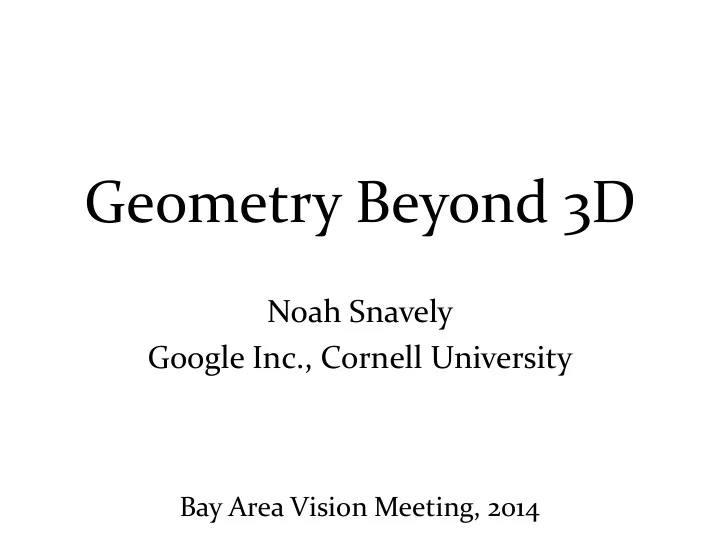

Geometry Beyond 3D Noah Snavely Google Inc., Cornell University Bay Area Vision Meeting, 2014
Are we done with 3D modeling? • Huge progress in the last 10 years [Snavely et al. SIGGRAPH06] [Pollefeys et al. IJCV04] [Zhou & Koltun , SIGGRAPH14] Aerial models
Are we done with 3D modeling? [Agarwal et al. ICCV 2009] [Klingner et al., ICCV 2013]
Are we done with 3D modeling? • Not until we have a fully realistic , editable , semantically meaningful model of the entire world • Realistic = correct geometry, materials, lighting; high-resolution; dynamic • In other words, a model you can feed into your holodeck See also the Visual Turing Test [Shan et al., 3DV 2013]
Times Square
What are the key challenges? • Scale – we have made great progress here • Robustness • Time • Materials • Semantics / grounding • My own biased view
Robustness
Are two things the same? • How do we know what we are looking at is the same or different?
Structural similarities break SfM
Structural similarities break SfM
Other examples St. Paul’s Cathedral Notre Dame Cathedral
Tracks should contain one 3D point
Tracks can conflate distinct points
SfM Disambiguation • Most methods reason about inconsistencies across many images • Inconsistencies in – Loops of pairwise geometries – Visibility – Sequencing – Global geometry [Zach et al., CVPR 2008], [Zach et al., CVPR 2010], [Roberts et al., CVPR 2011], [Jiang et al., CVPR 2012]
SfM Disambiguation in the Large • We wanted a solution that was – As simple as possible – Scalable to huge image collections • Intuition: visibility of points is (often) transitive [Wilson & Snavely, Network Principles for SfM. ICCV 2013]
Graph topology is a cue for ambiguities Schematic of a scene with an ambiguous feature (in red) Note that the two sides of the scene have different background (blue and green) [Wilson & Snavely, Network Principles for SfM. ICCV 2013]
Graph topology is a cue for ambiguities This structure can be seen in the visibility graph [Wilson & Snavely, Network Principles for SfM. ICCV 2013]
Larger example Bad tracks have more than one cluster of context. Measure this with the bipartite local clustering coefficient.
Larger example Bad tracks have more than one cluster of context. Measure this with the bipartite local clustering coefficient.
blcc is analagous to the local clustering coefficient
Filtering by blcc removes bad tracks Algorithm: ROC curve for classifying bad tracks 1. Compute a covering subgraph 2. Compute blcc for each track 3. Remove tracks lower than a threshold Use lowest threshold that separates the graph into a user-predetermined number of components. 4. Reconstruct each component separately 5. Rigidly merge components if possible Solid line: thresholding tracks on blcc. Dotted line: same, but on a more uniform subgraph.
Disambiguation results Sacre Coeur Basilica, Paris
Disambiguation results Before After Notre Dame Cathedral, Paris
Disambiguation results Seville Cathedral
Disambiguation results Outside the Louvre, Paris
Network Principles for SfM + Extremely fast method + Based on simple local reasoning + Very simple to implement - Can sometimes oversegment models - Theoretical guarantees? See also [Heinly et al. ECCV 2014]
Feature matching as recognition • Can’t we just solve this problem using appearance alone? • Better features or image metrics?
Time
Places are dynamic
5pointz, Queens
5pointz How do we model these time-varying scenes? [Graffiti Archaeology, Cassidy Curtis]
4D Cities [Frank Dellaert, Grant Schindler, et al.]
Scene Chronology Step 1 : Download photos from Flickr Step 2 : Reconstruct a single 3D model with all times mixed up together Step 3 : Recover the chronology of the scene Kevin Matzen and Noah Snavely, Scene Chronology , ECCV 2014 Best Paper Award Winner
Single 3D Model (from ~100,000 images) Per-Point Time Observations
Exploded View across Time Space-Time Point Clustering
Re-time-stamping Blue: original timestamp Red: our predicted timestamp
Weather Physics Times Square, 1922 People Eisenstadt, 1945
Materials
Sean Bell, Paul Upchurch, Noah Snavely, Kavita Bala, SIGGRAPH 2013 http://opensurfaces.cs.cornell.edu/
Sean Bell, Kavita Bala, Noah Snavely, SIGGRAPH 2014, http://intrinsic.cs.cornell.edu
Semantics / Grounding
Every image tells a story… José Luis Murillo Vivienne Gucwa
Grounding vision in the world 3D city models OpenStreetMap Weather data Bus schedules
https://nycopendata.socrata.com (https://data.sfgov.org/, https://data.seattle.gov/ , …)
Grounding vision in the world • Which direction is north? • What is the shape of the buildings? • What was the weather like? • Where are streets? • What is the #51 bus schedule in Rome? Goal : Integrate images into this ecosystem of geographic data
First steps: NYC3DCars [Kevin Matzen and Noah Snavely, ICCV 2013]
NYCOpenData Roadbeds
Vision grounded in the real world Overlayed GIS data Input photo Overlayed Google Earth models (roads / sidewalks / medians)
Annotated 3D Vehicles
Video
3D Detection
Appearance score Ground coverage score Elevation score 3D orientation score
Results Precision / Recall Orientation similarity / Recall
http://nyc3d.cs.cornell.edu/
Summary • Many interesting challenges in modeling the world • Contributions from every area (cf. much wonderful recent work): – Scene understanding, object detection, material recognition, illumination modeling, … – Learning?
Acknowledgements Students • National Science Foundation • Intel Center for Sean Bell Song Cao Daniel Hauagge Kevin Matzen Science and Technology – Visual Computing • Amazon AWS for Paul Upchurch Chun-Po Wang Scott Wehrwein Kyle Wilson Education Collaborators Dan Huttenlocher Yunpeng Li Dave Crandall Kavita Bala
Thank you! More information at http://www.cs.cornell.edu/~snavely/
Recommend
More recommend